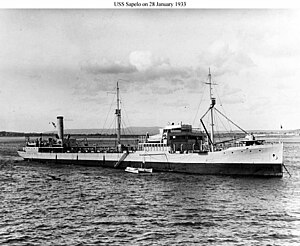USS Sapelo
 |
|
| History | |
|---|---|
|
|
|
| Name: | Sapelo |
| Namesake: | Sapelo River |
| Builder: | Newport News Shipbuilding and Dry Dock Co. |
| Laid down: | 3 May 1919 |
| Launched: | 24 December 1919 |
| Acquired: | 30 January 1920 |
| Commissioned: | 19 February 1920 |
| Decommissioned: | 14 October 1933 |
| Recommissioned: | 19 August 1940 |
| Decommissioned: | 26 October 1945 |
| Struck: | 13 November 1945 |
| Fate: | Sold for scrap, May 1946 |
| General characteristics | |
| Class and type: | Patoka Replenishment oiler |
| Displacement: | 16,500 long tons (16,765 t) full |
| Length: | 477 ft 10 in (145.64 m) |
| Beam: | 60 ft 3 in (18.36 m) |
| Draft: | 26 ft 2 in (7.98 m) |
| Speed: | 10.5 knots (19.4 km/h; 12.1 mph) |
| Complement: | 75 officers and enlisted |
| Armament: | 2 × 5 in (130 mm) guns |
USS Sapelo (AO-11) was a Patoka-class fleet replenishment oiler of the United States Navy. Laid down on 3 May 1919 for the United States Shipping Board by the Newport News Shipbuilding and Dry Dock Co., Newport News, Virginia, the ship was launched on 24 December 1919, transferred to the Navy on 30 January 1920, and commissioned on 19 February 1920, Comdr. W. R. Kennedy, USNRF, in command.
After carrying fuel oil from Texas ports to shore stations in Panama, Cuba, and on the east coast, Sapelo completed her first transatlantic run, to the Firth of Clyde with oil for the British Admiralty, in June 1920. On her return, she remained in American waters through mid-August; then loaded fuel oil, gasoline, and stores for store ships and shore stations supporting United States Navy ships operating in Adriatic and Turkish waters. During September, she delivered cargo at Constantinople, Constanţa, Venice, and Split. From there, she proceeded to Brest where she received American war dead to return to the United States.
On 29 October, Sapelo arrived at New York City and, for the next four years, alternately operated along the gulf coast, in the Caribbean, and along the east coast, with semi-annual one-to-three-month tours in the Mediterranean–Middle East area. In April 1924, she transited the Panama Canal and proceeded to San Pedro, California. From there, she refueled ships conducting exercises off the California, Mexican, and Panamanian coasts and carried fuel to shore bases in the Canal Zone. In June, she returned to the east coast; underwent overhaul; and, in August, resumed gulf coast-east coast-Caribbean shuttle runs.
...
Wikipedia
